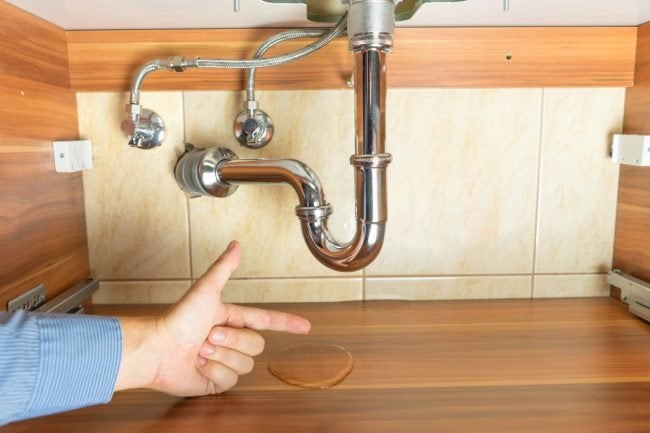Guide To Water Leak Discovery In The House
Guide To Water Leak Discovery In The House
Blog Article
This post following next about Leaking water lines is highly enjoyable. Check it out for yourself and figure out what you think of it.

Early discovery of dripping water lines can alleviate a prospective catastrophe. Some small water leaks may not be visible.
1. Analyze the Water Meter
Every residence has a water meter. Checking it is a proven manner in which helps you uncover leakages. For starters, switch off all the water resources. Make certain nobody will flush, use the tap, shower, run the washing device or dishwasher. From there, go to the meter and also watch if it will certainly alter. Because no one is utilizing it, there must be no motions. If it moves, that shows a fast-moving leakage. If you find no modifications, wait an hour or 2 as well as check back once more. This indicates you may have a slow-moving leak that can even be underground.
2. Check Water Usage
Assess your water costs and track your water intake. As the one paying it, you must notice if there are any kind of discrepancies. If you detect sudden changes, in spite of your intake being the same, it suggests that you have leakages in your plumbing system. Keep in mind, your water costs should drop under the very same range each month. An unexpected spike in your bill shows a fast-moving leakage.
A stable boost every month, also with the same routines, reveals you have a slow leak that's additionally slowly escalating. Call a plumber to completely examine your residential property, specifically if you really feel a warm area on your floor with piping beneath.
3. Do a Food Coloring Examination
When it concerns water usage, 30% originates from commodes. Test to see if they are running appropriately. Drop specks of food shade in the container and also wait 10 mins. There's a leakage between the storage tank and also bowl if the color somehow infiltrates your bowl throughout that time without flushing.
4. Asses Outside Lines
Don't forget to check your exterior water lines also. Must water permeate out of the link, you have a loose rubber gasket. One tiny leakage can lose heaps of water as well as surge your water bill.
5. Analyze the scenario as well as examine
House owners ought to make it a practice to examine under the sink counters and also even inside closets for any type of bad odor or mold development. These two red flags show a leak so punctual interest is required. Doing regular assessments, also bi-annually, can save you from a significant issue.
Examine for discolorations as well as weakening as many pipelines and also appliances have a life expectancy. If you presume dripping water lines in your plumbing system, don't wait for it to escalate.
Early discovery of leaking water lines can mitigate a potential calamity. Some small water leakages might not be noticeable. Examining it is a surefire method that helps you uncover leaks. One little leakage can lose heaps of water as well as surge your water costs.
If you suspect leaking water lines in your plumbing system, don't wait for it to intensify.
How to Know If Your Home Has a Hidden Leak
Water Meter Reveals Inexplicable Water Usage
If you’d like to test whether or not there’s a leak somewhere in your home, you can do this using your water meter. Here is how to conduct the test:
Don’t use any water in your home for at least 30 minutes; this also means not turning on faucets or water-using appliances.
Go outside, and check your water meter for activity.
If your water meter shows that there was activity, even though no one was using any water, this proves that there is a leak in your home.Visible Mold or Mildew Growth
Leaks behind walls create moist, dark environments that allow mold and mildew to grow and thrive. Eventually, you might see mold growth forming on the wall closest to a hidden leak.
If mold is growing in an area that receives a high amount of moisture, such as a bathroom, it may simply be an indication that better ventilation is needed. However, if you see mold growth on a wall or the ceiling in an area where you would not expect, you probably have a hidden leak.
Musty, Mildew Odor
Sometimes you might not be able to see the mold or mildew that is growing as a result of a leak. However, the smell can give the problem away just as easily. If you catch a whiff of something musty, there’s a good chance that old water is collecting somewhere in your home that you can’t see.
Stained/Warped Walls, Ceilings, or Floors
When your home soaks up water, a variety of red flags can become visible, including ceiling stains, bubbling drywall, warped walls, and sagging floors. While these issues can be caused by excess humidity, they can also be signs that a pipe or plumbing connection has started leaking behind your walls.
Inexplicably High Water Bill
After a while, you get a general sense for what your water bill should be. If you own a pool or sprinkler system, your bill will tend to be higher during summer. However, if you receive a water bill that seems especially high, and you can’t figure out what caused it, then you may have a hidden leak somewhere that’s increasing your bill.
https://www.plumbingjoint.com/blog/2019/july/how-to-know-if-your-home-has-a-hidden-leak/
.jpg)
I hope you enjoyed our article about Top leak detection hacks. Thank you for finding the time to read our piece. Enjoyed our posting? Please share it. Help another person check it out. Thanks a lot for your time. Please check our website back soon.
Report this page